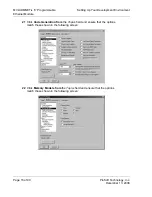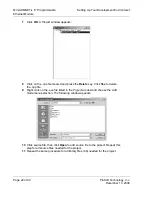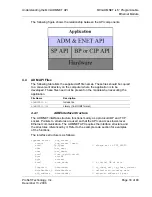
Setting Up Your Development Environment
MVI-ADMNET
♦
'C' Programmable
Ethernet Module
ProSoft Technology, Inc.
Page 27 of 90
December 13, 2006
Note:
If you are installing this module in an existing application, you can copy
the necessary elements from the example ladder logic into your application.
The rest of this chapter describes these steps in more detail.
Note for MVI94:
Configuration information for the MVI94-ADM module is
stored in the module's Flash ROM. This provides permanent storage of the
information. The user configures the module using a text file and then using
the terminal emulation software provided with the module to download it to the
module's Flash ROM. The file contains the configuration for the Flex
backplane data transfer, master port and the command list. This file is
downloaded to the module for each application.
Note for MVI69:
Configuration information for the MVI69-ADM module is
stored in the module's EEPROM. This provides permanent storage of the
information. The user configures the module using a text file and then using
the terminal emulation software provided with the module to download it to the
module's EEPROM. The file contains the configuration for the virtual database,
backplane data transfer, and serial port. This file is downloaded to the module
for each application.
Note for MVI71:
The first step in installing and configuring the module is to
define whether the block transfer or side-connect interface will be used. If the
block transfer interface is used, remove the Compact Flash Disk from the
module if present and insert the module into the rack with the power turned off.
3.3.1
Using Side-Connect (Requires Side-Connect
Adapter) (MVI71)
If the side-connect interface is used, the file SC_DATA.TXT on the Compact
Flash Disk must contain the correct configuration file number. To set the
configuration file number to be used with your application, run the setdnpsc.exe
program. Install the module in the rack and turn on the power. Connect the
terminal emulator to the module's debug/configuration port and exit the program
by pressing the Esc key followed by the "X" key. This causes the program to exit
and remain at the operating system prompt. Run the setdnpsc.exe program with
a command line argument of the file number to use for the configuration file. For
example, to select N10: as the configuration file, enter the following:
SETDNPSC 10
The program will build the SC_DATA.TXT on the Compact Flash Disk (C: drive in
the root directory).
The next step in module setup is to define the data files to be used with the
application. If the block transfer interface is used, define the data files to hold the
configuration, status, and user data. Enter the module's configuration in the user
data files. Enter the ladder logic to handle the blocks transferred between the
module and the PLC. Download the program to the PLC and test the program
with the module.
















































